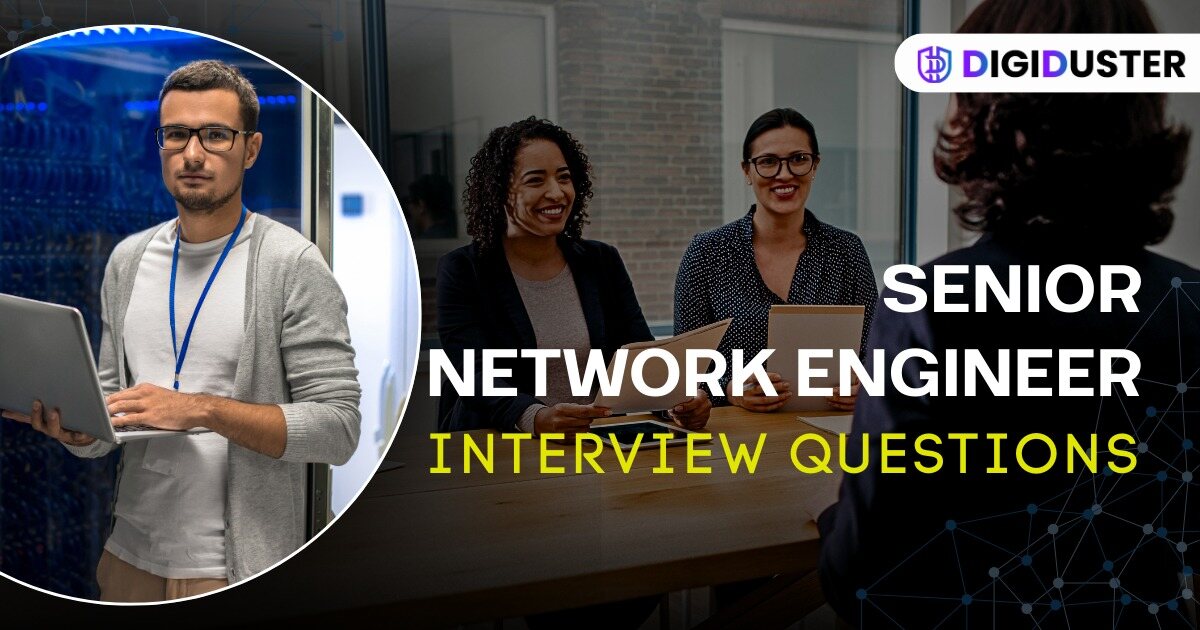Got an interview for a senior network engineer job? Don’t stress. You’re not alone. And we’ve got your back! In this blog, we’ll go through 50+ senior network engineer interview questions with easy answers. Whether you’re brushing up your skills or starting fresh, this will help you feel more confident.
We’ll also drop some bonus tips to help you shine in your interview. No tech jargon, just easy talk. Let’s get into it!
What is a Senior Network Engineer?
Think of a senior network engineer as an internet doctor for companies.
When something breaks in the network or slows down, they’re the ones who fix it. They also build and maintain the network so that everything works smoothly — from video calls to emails to big data transfers.
Big companies need them to keep the digital world running behind the scenes. They protect data, solve problems fast, and make sure systems talk to each other securely.
🛠️ Responsibilities:
-
Design and set up secure networks
-
Troubleshoot network issues
-
Monitor performance
-
Install new equipment
-
Manage upgrades
🧠 Key Skills:
-
Problem-solving
-
Knowledge of protocols (like TCP/IP, DNS)
-
Understanding of firewalls and routing
-
Scripting (basic Python or Bash)
-
Good communication
🧰 Common Tools:
-
Wireshark
-
Cisco Packet Tracer
-
SolarWinds
-
Nagios
-
Putty, Nmap, PRTG
Top 50+ Senior Network Engineer Interview Questions & Answers (2025)
Let’s break it down into topics so it’s easy to read.
🛠️ A. Technical Questions
- What’s the difference between a router and a switch?
A router connects networks. A switch connects devices inside one network. - How does a DNS work?
It turns domain names into IP addresses so your browser knows where to go. - What is subnetting, and why is it useful?
It divides networks into smaller parts. Helps improve performance and security. - What is NAT?
Network Address Translation. It lets many devices share one public IP. - What is a default gateway?
It’s the path out of your network to the internet. - What’s a MAC address?
A unique address is given to each device’s network card. - What is the difference between TCP and UDP?
TCP is reliable and slower. UDP is faster, but no delivery guarantee. - What is a trunk port?
It carries multiple VLANS across a single link. - What’s OSPF?
Open Shortest Path First. A routing protocol used inside large networks. - What is BGP used for?
Border Gateway Protocol helps connect different networks across the internet. - What is ARP?
Address Resolution Protocol maps IP addresses to MAC addresses. - How do you find a network bottleneck?
Use traceroute, ping, or monitoring tools to find slow points. - How do you secure a wireless network?
Use strong passwords and encryption (like WPA3), and hide the SSID. - What’s a loop in a network?
When data keeps moving in circles, it is often caused by bad switch settings. - What’s the purpose of STP?
Spanning Tree Protocol stops loops in networks with multiple paths.
See also: What is Prompt Engineering & How to Start a Career in AI
🔐 B. Security Questions
- What is a firewall?
A tool that blocks bad traffic and allows safe data through. - What are IDS and IPS?
IDS detects threats. IPS detects and blocks them. - How do you handle a DDoS attack?
Limit traffic, use firewalls, reroute, and work with ISPS. - What is port security?
Locks down switch ports to prevent unauthorised access. - How do you update network firmware securely?
Download from trusted sources, test first, back up configs, then update.
📈 C. Experience-Based Questions
- Tell me about a time you fixed a big issue.
Give a real story. Show your thinking and how it helped. - Have you led any projects?
Talk about planning, leading, and results. - How do you handle a failed upgrade?
Roll back if needed. Inform users. Fix fast and document everything. - How do you manage network documentation?
Keep updated diagrams, IP lists, and change logs. - What’s your biggest network success?
Share a proud moment that saved time, money, or stress.
💡 D. Problem-Solving Questions
- How would you handle an outage during peak hours?
Stay calm, check basics, alert the team, troubleshoot fast. - What would you do if half the office lost access?
Check the switch, VLANS, and cabling. Compare affected and working zones. - How do you design a network for 300 users?
Use VLANS, good switching, strong firewall, and scalability. - How do you reduce network downtime?
Monitoring, backups, alerts, redundancy, and regular maintenance. - How do you test network performance?
Use tools to check latency, jitter, speed, and packet loss.
🔧 E. Tools & Technology Questions
- Which tools do you use daily?
Wireshark, SolarWinds, Putty, and PRTG. - What’s your go-to network monitoring tool?
Depends on the company. SolarWinds is great. - What’s the best way to log network changes?
Use change logs or ticketing systems like Jira. - What is SNMP?
Simple Network Management Protocol. Used to monitor and manage devices. - How do you automate routine tasks?
With scripts using Bash, Python, or Ansible.
🧍 F. Soft Skills Questions
- How do you explain technical stuff to non-tech people?
Use simple words, draw diagrams, and give real-world examples. - How do you stay updated?
Tech blogs, YouTube, certifications, online communities. - How do you deal with tough coworkers?
Stay calm, talk it out, and focus on solutions. - How do you handle stress during outages?
Take deep breaths, focus on the fix, and stay professional. - Do you prefer working alone or in a team?
Both. I enjoy solving problems solo and collaborating, too.
🆕 2025-Specific & Trend Questions
- How do you secure remote workers?
VPNS, strong passwords, MFA, and endpoint protection. - What’s SASE?
Secure Access Service Edge. It blends networking and security in the cloud. - How do you handle cloud networking?
Use tools like AWS VPC, Azure NSGS, and hybrid network setups. - What’s Zero Trust Networking?
Never trust, always verify. Every device/user needs authentication. - Are you familiar with SD-WAN?
Yes, it’s a modern way to connect branches over different types of networks. - What’s your experience with IPv6?
Setup, DNS, dual-stack networks — growing need in 2025. - Do you use automation tools like Ansible?
Yes, especially for configs and mass changes. - How do you monitor Iot devices?
Use segmenting, SNMP, and Iot-aware monitoring tools. - What are the challenges of hybrid cloud networks?
Security, latency, and managing across multiple platforms. - Where do you see networking in 5 years?
More cloud, automation, AI-driven monitoring, and stronger security.
🌟 Bonus Tips to Shine in the Interview
-
Dress smart but comfy
-
Prepare 2–3 real stories of your past work
-
Stay calm, even if you don’t know something
-
Ask clarifying questions when needed
-
Avoid tech slang unless asked
-
Don’t blame past teams
How to Make Channel on YouTube and Earn Money | A Complete Guide
🚀 Conclusion: You’re Ready, Go Rock That Interview!
That’s it! You’ve got all the basic senior network engineer interview questions, answers, and tips you need.
You know more than you think.
Be calm. Be clear. Be confident.
👉 Share this with your tech friends.
👉 Next up: Top Resume Tips for Network Engineers
❓ FAQ Section (SEO Boost)
Q: What should I expect in a senior network engineer interview?
Expect technical, security, problem-solving, and experience-based questions.
Q: How do I prepare for a network engineer technical interview?
Review basics, tools, and projects. Practice giving short, clear answers.
Q: What are the top skills for senior network engineers?
Troubleshooting, network design, scripting, documentation, and teamwork.
Q: Do senior engineers get asked coding questions?
Not deep coding. But, light scripting is common — like Python or Bash.



